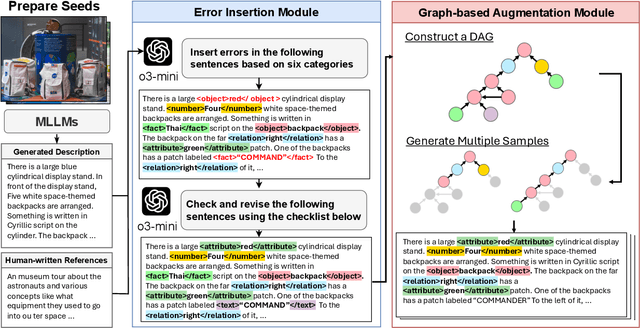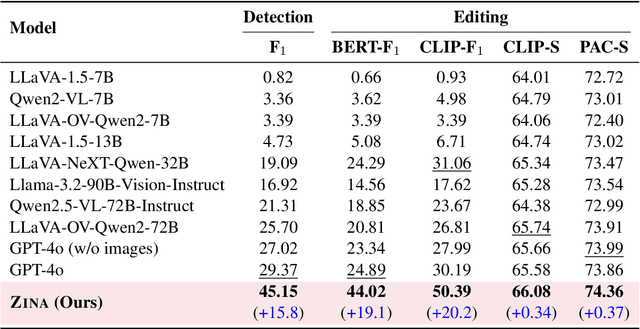Graham Neubig
Carnegie Mellon University
The Tool Decathlon: Benchmarking Language Agents for Diverse, Realistic, and Long-Horizon Task Execution
Oct 29, 2025Abstract:Real-world language agents must handle complex, multi-step workflows across diverse Apps. For instance, an agent may manage emails by coordinating with calendars and file systems, or monitor a production database to detect anomalies and generate reports following an operating manual. However, existing language agent benchmarks often focus on narrow domains or simplified tasks that lack the diversity, realism, and long-horizon complexity required to evaluate agents' real-world performance. To address this gap, we introduce the Tool Decathlon (dubbed as Toolathlon), a benchmark for language agents offering diverse Apps and tools, realistic environment setup, and reliable execution-based evaluation. Toolathlon spans 32 software applications and 604 tools, ranging from everyday platforms such as Google Calendar and Notion to professional ones like WooCommerce, Kubernetes, and BigQuery. Most of the tools are based on a high-quality set of Model Context Protocol (MCP) servers that we may have revised or implemented ourselves. Unlike prior works, which primarily ensure functional realism but offer limited environment state diversity, we provide realistic initial environment states from real software, such as Canvas courses with dozens of students or real financial spreadsheets. This benchmark includes 108 manually sourced or crafted tasks in total, requiring interacting with multiple Apps over around 20 turns on average to complete. Each task is strictly verifiable through dedicated evaluation scripts. Comprehensive evaluation of SOTA models highlights their significant shortcomings: the best-performing model, Claude-4.5-Sonnet, achieves only a 38.6% success rate with 20.2 tool calling turns on average, while the top open-weights model DeepSeek-V3.2-Exp reaches 20.1%. We expect Toolathlon to drive the development of more capable language agents for real-world, long-horizon task execution.
How Do AI Agents Do Human Work? Comparing AI and Human Workflows Across Diverse Occupations
Oct 26, 2025Abstract:AI agents are continually optimized for tasks related to human work, such as software engineering and professional writing, signaling a pressing trend with significant impacts on the human workforce. However, these agent developments have often not been grounded in a clear understanding of how humans execute work, to reveal what expertise agents possess and the roles they can play in diverse workflows. In this work, we study how agents do human work by presenting the first direct comparison of human and agent workers across multiple essential work-related skills: data analysis, engineering, computation, writing, and design. To better understand and compare heterogeneous computer-use activities of workers, we introduce a scalable toolkit to induce interpretable, structured workflows from either human or agent computer-use activities. Using such induced workflows, we compare how humans and agents perform the same tasks and find that: (1) While agents exhibit promise in their alignment to human workflows, they take an overwhelmingly programmatic approach across all work domains, even for open-ended, visually dependent tasks like design, creating a contrast with the UI-centric methods typically used by humans. (2) Agents produce work of inferior quality, yet often mask their deficiencies via data fabrication and misuse of advanced tools. (3) Nonetheless, agents deliver results 88.3% faster and cost 90.4-96.2% less than humans, highlighting the potential for enabling efficient collaboration by delegating easily programmable tasks to agents.
MERLIN: A Testbed for Multilingual Multimodal Entity Recognition and Linking
Oct 16, 2025Abstract:This paper introduces MERLIN, a novel testbed system for the task of Multilingual Multimodal Entity Linking. The created dataset includes BBC news article titles, paired with corresponding images, in five languages: Hindi, Japanese, Indonesian, Vietnamese, and Tamil, featuring over 7,000 named entity mentions linked to 2,500 unique Wikidata entities. We also include several benchmarks using multilingual and multimodal entity linking methods exploring different language models like LLaMa-2 and Aya-23. Our findings indicate that incorporating visual data improves the accuracy of entity linking, especially for entities where the textual context is ambiguous or insufficient, and particularly for models that do not have strong multilingual abilities. For the work, the dataset, methods are available here at https://github.com/rsathya4802/merlin
Grounding Multilingual Multimodal LLMs With Cultural Knowledge
Aug 12, 2025Abstract:Multimodal Large Language Models excel in high-resource settings, but often misinterpret long-tail cultural entities and underperform in low-resource languages. To address this gap, we propose a data-centric approach that directly grounds MLLMs in cultural knowledge. Leveraging a large scale knowledge graph from Wikidata, we collect images that represent culturally significant entities, and generate synthetic multilingual visual question answering data. The resulting dataset, CulturalGround, comprises 22 million high-quality, culturally-rich VQA pairs spanning 42 countries and 39 languages. We train an open-source MLLM CulturalPangea on CulturalGround, interleaving standard multilingual instruction-tuning data to preserve general abilities. CulturalPangea achieves state-of-the-art performance among open models on various culture-focused multilingual multimodal benchmarks, outperforming prior models by an average of 5.0 without degrading results on mainstream vision-language tasks. Our findings show that our targeted, culturally grounded approach could substantially narrow the cultural gap in MLLMs and offer a practical path towards globally inclusive multimodal systems.
SimuRA: Towards General Goal-Oriented Agent via Simulative Reasoning Architecture with LLM-Based World Model
Jul 31, 2025Abstract:AI agents built on large language models (LLMs) hold enormous promise, but current practice focuses on a one-task-one-agent approach, which not only falls short of scalability and generality, but also suffers from the fundamental limitations of autoregressive LLMs. On the other hand, humans are general agents who reason by mentally simulating the outcomes of their actions and plans. Moving towards a more general and powerful AI agent, we introduce SimuRA, a goal-oriented architecture for generalized agentic reasoning. Based on a principled formulation of optimal agent in any environment, \modelname overcomes the limitations of autoregressive reasoning by introducing a world model for planning via simulation. The generalized world model is implemented using LLM, which can flexibly plan in a wide range of environments using the concept-rich latent space of natural language. Experiments on difficult web browsing tasks show that \modelname improves the success of flight search from 0\% to 32.2\%. World-model-based planning, in particular, shows consistent advantage of up to 124\% over autoregressive planning, demonstrating the advantage of world model simulation as a reasoning paradigm. We are excited about the possibility for training a single, general agent model based on LLMs that can act superintelligently in all environments. To start, we make SimuRA, a web-browsing agent built on \modelname with pretrained LLMs, available as a research demo for public testing.
Checklists Are Better Than Reward Models For Aligning Language Models
Jul 24, 2025Abstract:Language models must be adapted to understand and follow user instructions. Reinforcement learning is widely used to facilitate this -- typically using fixed criteria such as "helpfulness" and "harmfulness". In our work, we instead propose using flexible, instruction-specific criteria as a means of broadening the impact that reinforcement learning can have in eliciting instruction following. We propose "Reinforcement Learning from Checklist Feedback" (RLCF). From instructions, we extract checklists and evaluate how well responses satisfy each item - using both AI judges and specialized verifier programs - then combine these scores to compute rewards for RL. We compare RLCF with other alignment methods applied to a strong instruction following model (Qwen2.5-7B-Instruct) on five widely-studied benchmarks -- RLCF is the only method to improve performance on every benchmark, including a 4-point boost in hard satisfaction rate on FollowBench, a 6-point increase on InFoBench, and a 3-point rise in win rate on Arena-Hard. These results establish checklist feedback as a key tool for improving language models' support of queries that express a multitude of needs.
OpenAgentSafety: A Comprehensive Framework for Evaluating Real-World AI Agent Safety
Jul 08, 2025



Abstract:Recent advances in AI agents capable of solving complex, everyday tasks, from scheduling to customer service, have enabled deployment in real-world settings, but their possibilities for unsafe behavior demands rigorous evaluation. While prior benchmarks have attempted to assess agent safety, most fall short by relying on simulated environments, narrow task domains, or unrealistic tool abstractions. We introduce OpenAgentSafety, a comprehensive and modular framework for evaluating agent behavior across eight critical risk categories. Unlike prior work, our framework evaluates agents that interact with real tools, including web browsers, code execution environments, file systems, bash shells, and messaging platforms; and supports over 350 multi-turn, multi-user tasks spanning both benign and adversarial user intents. OpenAgentSafety is designed for extensibility, allowing researchers to add tools, tasks, websites, and adversarial strategies with minimal effort. It combines rule-based analysis with LLM-as-judge assessments to detect both overt and subtle unsafe behaviors. Empirical analysis of five prominent LLMs in agentic scenarios reveals unsafe behavior in 51.2% of safety-vulnerable tasks with Claude-Sonnet-3.7, to 72.7% with o3-mini, highlighting critical safety vulnerabilities and the need for stronger safeguards before real-world deployment.
ZINA: Multimodal Fine-grained Hallucination Detection and Editing
Jun 16, 2025



Abstract:Multimodal Large Language Models (MLLMs) often generate hallucinations, where the output deviates from the visual content. Given that these hallucinations can take diverse forms, detecting hallucinations at a fine-grained level is essential for comprehensive evaluation and analysis. To this end, we propose a novel task of multimodal fine-grained hallucination detection and editing for MLLMs. Moreover, we propose ZINA, a novel method that identifies hallucinated spans at a fine-grained level, classifies their error types into six categories, and suggests appropriate refinements. To train and evaluate models for this task, we constructed VisionHall, a dataset comprising 6.9k outputs from twelve MLLMs manually annotated by 211 annotators, and 20k synthetic samples generated using a graph-based method that captures dependencies among error types. We demonstrated that ZINA outperformed existing methods, including GPT-4o and LLama-3.2, in both detection and editing tasks.
CAIRe: Cultural Attribution of Images by Retrieval-Augmented Evaluation
Jun 10, 2025Abstract:As text-to-image models become increasingly prevalent, ensuring their equitable performance across diverse cultural contexts is critical. Efforts to mitigate cross-cultural biases have been hampered by trade-offs, including a loss in performance, factual inaccuracies, or offensive outputs. Despite widespread recognition of these challenges, an inability to reliably measure these biases has stalled progress. To address this gap, we introduce CAIRe, a novel evaluation metric that assesses the degree of cultural relevance of an image, given a user-defined set of labels. Our framework grounds entities and concepts in the image to a knowledge base and uses factual information to give independent graded judgments for each culture label. On a manually curated dataset of culturally salient but rare items built using language models, CAIRe surpasses all baselines by 28% F1 points. Additionally, we construct two datasets for culturally universal concept, one comprising of T2I-generated outputs and another retrieved from naturally occurring data. CAIRe achieves Pearson's correlations of 0.56 and 0.66 with human ratings on these sets, based on a 5-point Likert scale of cultural relevance. This demonstrates its strong alignment with human judgment across diverse image sources.
FieldWorkArena: Agentic AI Benchmark for Real Field Work Tasks
May 26, 2025Abstract:This paper proposes FieldWorkArena, a benchmark for agentic AI targeting real-world field work. With the recent increase in demand for agentic AI, they are required to monitor and report safety and health incidents, as well as manufacturing-related incidents, that may occur in real-world work environments. Existing agentic AI benchmarks have been limited to evaluating web tasks and are insufficient for evaluating agents in real-world work environments, where complexity increases significantly. In this paper, we define a new action space that agentic AI should possess for real world work environment benchmarks and improve the evaluation function from previous methods to assess the performance of agentic AI in diverse real-world tasks. The dataset consists of videos captured on-site and documents actually used in factories and warehouses, and tasks were created based on interviews with on-site workers and managers. Evaluation results confirmed that performance evaluation considering the characteristics of Multimodal LLM (MLLM) such as GPT-4o is feasible. Additionally, the effectiveness and limitations of the proposed new evaluation method were identified. The complete dataset (HuggingFace) and evaluation program (GitHub) can be downloaded from the following website: https://en-documents.research.global.fujitsu.com/fieldworkarena/.
 Add to Chrome
Add to Chrome Add to Firefox
Add to Firefox Add to Edge
Add to Edge